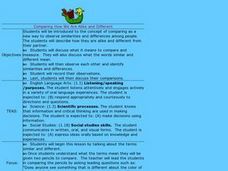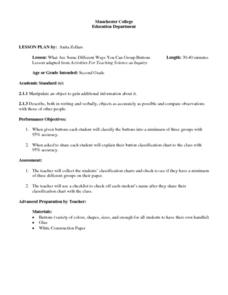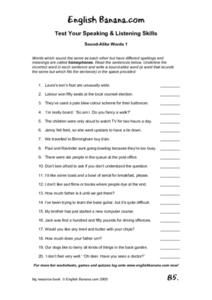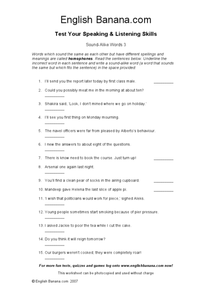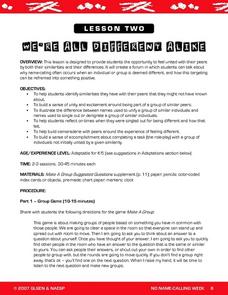Teaching Tolerance
Using Photographs to Teach Social Justice | Affirming Our Commonalities and Differences
Photos can challenge stereotypes. To gain an understanding of the big picture, groups examine a series of photographs and analyze how a photographer's choices can shape a viewer's reaction to an image. For the first set of photographs,...
Curated OER
The Flow of Women's Work: How Cultures are Alike and Different?
Students examine gender roles in various cultures. In this flow of women's work lesson, students compare water related work in rural Africa to that in their own households.
Curated OER
We're Alike, We're Different!
Students compare a variety of people counters to determine how they're alike and different and then sort, classify and write about how they sort and classify people counters.
Curated OER
Plants and Animals: Alike and Not Alike
After reading an informative paragraph that outlines some of the differences between plants and animals, fifth graders attempt to correctly categorize 12 words in a word bank. They must put them in the plant, or animal category. This...
Curated OER
Comparing How We Are Alike and Different
Students introduced to comparing as a way to observe differences among people.
Curated OER
What Are Some Different Ways You Can Group Buttons
Second graders classify and group buttons. They discuss how their buttons are alike and different, and identify the characteristics of their handful of buttons. Students then classify their buttons into three groups, and create a...
Arkansas Government
Creative Adventures with Literature - Whoever You Are
Celebrate our similarities and differences through multiple readings of Whoever you Are by Mem Fox. Readings are accompanied by a grand discussion, charts, creative art, dramatic, and music play to reinforce the uniqueness that is...
Curated OER
We are all alike, We are all different
Students investigate similarites and differences. In this multi-cultural lesson, students discuss how people are alike and how they are different by comparing apples to people.
Curated OER
Test Your Speaking & Listening Skills: Sound-Alike Words 1
In this listening and speaking instructional activity, students will read 20 sentences each containing a misspelled homophone. Then students will circle the misspelled homophone and write the correct sound alike word on the line.
Curated OER
Speaking and Listening Sound Alike Words
In this alike words worksheet, students read the sentences, underline the incorrect words, and write a sound-alike word for the 20 sentences.
Curated OER
People-Growing and Changing
Second graders study how people grow and change. In this health lesson, 2nd graders describe how they have changed over the years and guess who each student is after looking at everyone's baby pictures.
Cornell University
Forensic Science: Case of the Missing Diamond Maker
Someone stole a diamond-making machine. Who done it? Scholars use forensic science at six different stations to determine the culprit. They analyze fingerprints, use their senses, and complete chemistry experiments to determine the...
Curated OER
Ways we are Alike/ Ways we are Different
Students complete a chart comparing and contrasting African villages with their own communities. The lesson focuses on the Mbuti and Fulani people. They explore their style of living, their traditions and everyday life in these villages.
Curated OER
We're all different alike?
Students identify similarities and differences that they have with their peers. They explore why name-calling often occurs when an individual or group is deemed different, and how this targeting can be reframed into something positive
Pittsburg Area Chamber of Commerce
Introductions: Team Building
Whether its in the classroom, on the basketball court, or in the office, being able to work as part of team is essential for people of all ages and in all walks of life. Help build this important skill in your students with this...
Possibilities
Disability Awareness Activity Packet
Bring awareness to disabilities with a packet consisting of a variety of activities designed to inform scholars about disabilities—autism, hearing impairments, physical disabilities, and more! Learners test their communication...
K5 Learning
Musical Instruments to Play
Bring some music to your language arts lesson with a reading comprehension activity. Learners read an informational passage about different musical instruments before answering a series of comprehension and vocabulary questions.
Curated OER
We Are Alike, We Are Different:A Focus on Japan
First graders develop a connection with students in a first grade classroom in Japan. They begin to develop a curiosity about Japan--the landscape, the people, and their culture, while developing an understanding of the Five Themes of...
Curated OER
Where People Work
Students investigate where people work. In this social studies lesson, students use a Landscape Picture to locate places of work. Students discuss how each job is similar and different.
Curated OER
Landscape Picture Map: Natural and People Made Features
Students explore the places and objects that make up the Earth's surface. In this natural and people made features lesson, students identify things they've seen that are people made and those that are natural to the environment. ...
Read In English
White Fang
White Fang gets into the mind of a wild wolfdog as people domesticate him. The story tells of trials with violent animals and humans alike. White Fang captures readers' hearts as the pup separates from his family.
Foreign Policy Research Institute
Intro to China
Understanding the global interconnection between people of other nations is extremely important in our ever-shrinking world. Emergent global thinkers examine the significance of Chinese culture, religion, and political power. They then...
Curated OER
Acceptance Through Patchwork
Learners are asked to look at differences in people and accept those differences but to examine that people are more alike than different. The lesson has the central focus of investigating diversity.
Museum of Disability
Don't Call Me Special
Introduce young learners to the idea of disabilities and making friends with children who are different than they are. Using Don't Call Me Special - A First Look at Disability by Pat Thomas, learners are guided through the new...






